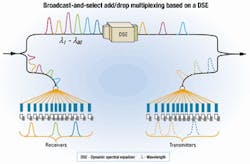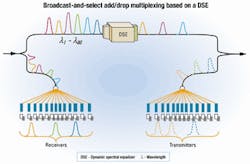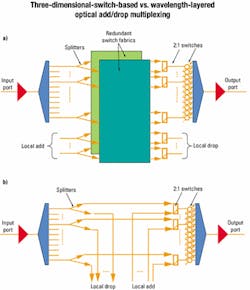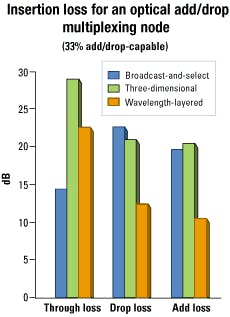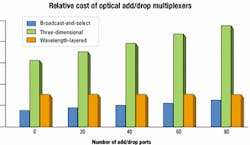Broadcast-and-select OADM enables low-cost transparency
The dynamic spectral equalizer is a key enabling technology for this emerging architecture.
JOHN BAYNE and MANISH SHARMA, Corning Inc.
The growth of data and Internet traffic has spurred significant changes in traffic patterns across long-haul backbone networks. Internet traffic tends to travel much longer distances than conventional voice circuits, which are typically confined to local communities of interest. Consequently, studies predict that from 2000 to 2005, the average connection distances in North America will increase from 740 km to more than 2,700 km.
That fundamental change in traffic patterns requires an equally dramatic shift in the way networks are designed and operated. Now, network node designs must accommodate both higher bandwidth and longer connection circuits. The opaque approach, which regenerates all signals at every node, works for voice traffic where 60% of connections terminate within 600 km. But with Internet traffic, where 60% of the connections reach 3,000 km, that architecture becomes extremely inefficient, because it mandates optical-electrical-optical (OEO) conversion at all intermediate nodes, even if the majority of the signals are express.
In response to the demands of Internet and data traffic, network designers have begun to introduce remotely configurable optical architectures that lower cost by increasing transparency and reducing OEO conversions. Broadcast-and-select optical add/drop multiplexing (OADM) represents an emerging architecture tailored to the particular demands of data and Internet traffic. It has been adopted by original equipment manufacturers such as Marconi, which won a major contract with British Telecom based on its remotely configurable OADM system.
Broadcast-and-select outperforms traditional approaches in all the key dimensions:
- Achieves greater distances without re generation by enabling exceptionally low loss on through-channels.
- Offers lower first-installed cost than conventional approaches by integrating the multiplexing, switching, and equalization functions in fewer components.
- Scales more cost-effectively than conventional approaches, because wavelength access can be added as needed.
The basic architecture of a broadcast-and-select OADM is shown in Figure 1. Broadcast-and-select OADMs use splitters to broadcast the entire multiwavelength input signal entering the node to every drop port and the through-path. Single-channel optical filters select the wavelengths to be dropped; these devices can be simple fixed filters or tunable filters, depending on the flexibility required at the add/drop port.
On the through-path, channels to be dropped are blocked by a wavelength-selective device such as a dynamic spectral equalizer (DSE). Wavelengths with new information can then be added with a passive coupler. In addition to blocking channels, the DSE selectively attenuates the channels that pass through. This power equalization function reduces the impact of gain ripple in the inline erbium-doped fiber amplifiers (EDFAs). System designers then have two options to reduce total system cost: deploy lower-cost EDFAs with higher gain ripple or use high-performance amplifiers and extend system reach.Note that this node structure also has full "drop and continue" capability, a key feature to enable protected ring interconnection. It is also east-west separable; there is no single point of failure that could cause both the add and the drop capability to fail on the same fiber. That is a key requirement to allow SONET bidirectional line-switched ring or other shared protection schemes to operate correctly with the OADM.
More conventional methods of building OADMs are shown in Figures 2a and 2b. In these architectures, all of the incoming optical wavelength channels are demultiplexed, then switched and remultiplexed at the output port. The switch allows wavelengths to pass through the node or to be added or dropped. Variable optical attenuators or single-channel amplifiers are typically required on each input port of the multiplexer in order to be able to perform channel power equalization.
Switching can be performed using either a fully connected three-dimensional switch fabric (see Figure 2a) or on a wavelength-by-wave length basis (see Figure 2b). If wavelength-reconfigurable drop ports, which enable any wavelength to be added or dropped at any port, are required in the wavelength-layered case, then an additional large optical-switch matrix on the drop ports is needed.
The OADM based on a fully connected three-dimensional (3-D) optical switch al ready includes this functionality. A single large switch core must be deployed in a redundant configuration (see Figure 2a) to avoid a single point of failure. The complexity of this approach adds cost and does not allow for the modularity or the scalability of broadcast-and-select OADMs.
Broadcast-and-select architecture provides the network transparency to efficiently handle the high percentage of pass-through channels characteristic of Internet traffic. Low-loss (typically 6-dB) wavelength blocking devices such as the DSE can easily handle 80 or 100 wavelengths on a 50-GHz grid. As a result, the through-channel insertion loss of broadcast-and-select is very low compared to other OADM architectures.Figure 3 compares the insertion loss of a broadcast-and-select OADM with a conventional wavelength-layered and fully connected 3-D switch-matrix-based OADM. Broadcast-and-select results in dramatically reduced insertion loss for through-channels. That, however, is gained at the expense of greater add and drop channel loss for nodes where a large fraction of the traffic is being terminated. The tradeoff is justified because OADMs will typically be used at nodes where the majority of the traffic is pass-through. Recent studies have shown that an average of 70% of traffic is intended to pass through the network node. That means a signal traveling through the network goes through a large number of nodes on the through state while add/drop just happens once.
Lower loss for the through-channels translates into better optical performance and longer-reach networks. Ultra-long-haul (ULH) networks particularly have little tolerance for the optical signal-to-noise-ratio (OSNR) degradation generated from OADMs with higher insertion loss. Hence, the more traditional OADM architectures will require many more single-channel amplifiers within the OADM to compensate for insertion loss while minimizing OSNR degradation.
The broadcast-and-select architecture, however, with its lower through-channel insertion loss, requires only two EDFAs, one on the input port and one on the output port. A broadcast-and-select OADM could also fit within a two-stage amplifier.
In addition, broadcast-and-select architecture greatly simplifies fiber management. Only those channels being dropped or added are broken out onto individual fibers-all other through-channels remain in a single fiber. That dramatically reduces the number of connectors in the node and leads to simpler assembly, installation, maintenance, and ultimately higher reliability.
The design of the DSE can also provide benefits. For example, liquid-crystal-based DSEs with unique filter shapes are available whose flat top and sharp out-of-band roll-off allow channels to pass through with minimal signal distortion. In addition, when contiguous channels transit through the DSE, there is no interchannel filtering and thus the signals pass through the device without any distortion. This benefit enables high-bit-rate channels to be packed into the available optical spectrum with the highest possible spectral efficiency.The cost advantage of broadcast-and-select OADM stems from its lower insertion loss on through-channels (which reduces the need for amplification), its more efficient demultiplexing-attenuation-multiplexing functionality, and its graceful scalability. Figure 4 compares the cost for the broadcast-and-select OADM with that of the more conventional OADM architectures.
For nodes dropping relatively small numbers of channels, the broadcast-and-select approach provides clear advantages and offers significant cost savings, because the drop filters can be added one at a time as the number of drop channels increases. Compared to wavelength-layered OADM (the next best alternative), the broadcast-and-select approach has a 50% lower first-installed cost (i.e., cost when only a single channel is added or dropped). Even when all channels are added or dropped, the broadcast-and-select approach still shows a cost advantage.
Broadcast-and-select moves cost and complexity out of the transit path of ex press channels, while only slightly in creasing the complexity of the add/ drop signal paths. In today's network, a system that offers lower cost and lower insertion loss on the express path makes sense on multiple fronts. It minimizes first-installed cost while offering pay-as-you-go scalability on the add/ drop ports, supports 100% of express traffic on day one without the need for additional hardware (a feature that enables remote provisioning of express traffic), reduces optical impairments for application in ULH networks, and efficiently handles the high levels of express traffic brought on by the Internet-induced shift to longer circuit paths.A wavelength-selective device such as the DSE represents the key enabling technology for broadcast-and-select optical add/drop multiplexers. The device must be capable of simultaneous channel blocking and equalization. A minimum of 35-dB isolation, preferably 40-dB, is required to ensure sufficient signal suppression to prevent in-band crosstalk from degrading the wavelength channels that are added. Wide dynamic range, with low polarization-dependent loss, is also necessary so the device can attenuate the pass-through channels from 0 to 15 dB. Finally, the device should be remotely configurable. A key cost benefit of the broadcast-and-select architecture is that system operators can remotely configure spectrum allocation and wavelength selection to enable fast provisioning of wavelengths. Considering that one coast-to-coast OC-48 wavelength in North America generates approximately $400,000 a month and that provisioning time can take up to six months, it be comes clear that manual provisioning re presents a substantial opportunity cost to service providers.
The operation of the DSE is shown in Figure 5. A grating spatially separates the incoming multiwavelength signals, then a liquid-crystal spatial light modulator selectively blocks or attenuates signals. Finally, another grating is used to recombine the optical signals into a single fiber. This design can be used to achieve all the key design objectives for use in a broadcast-and-select OADM: low insertion, high isolation, and ideal spectral shape.
Tunable filters add value to the broadcast-and-select OADM node by enabling access to any wavelength at any add/drop port. This wavelength configurability is particularly useful in large mesh networks where it can be used to enable restoration and remote provisioning of intermediate regenerators.
As data and Internet traffic continue to drive the need for higher bandwidth and longer connection distances, network designs must enable low-cost transparency. Broadcast-and-select OADM lowers the cost of transparent networks, because it offers significantly reduced insertion loss for express channels, built-in spectral equalization capability, lower first-installed cost, and a graceful upgrade path.
Optical-networking devices that provide dynamic per-channel equalization and blocking enable this emerging architecture. And tunable-filter products add further value by providing complete wavelength flexibility at the network node.
John Bayne is director, optical-networking products, and Manish Sharma is a senior marketing manager at Corning Inc. (Corning, NY).
